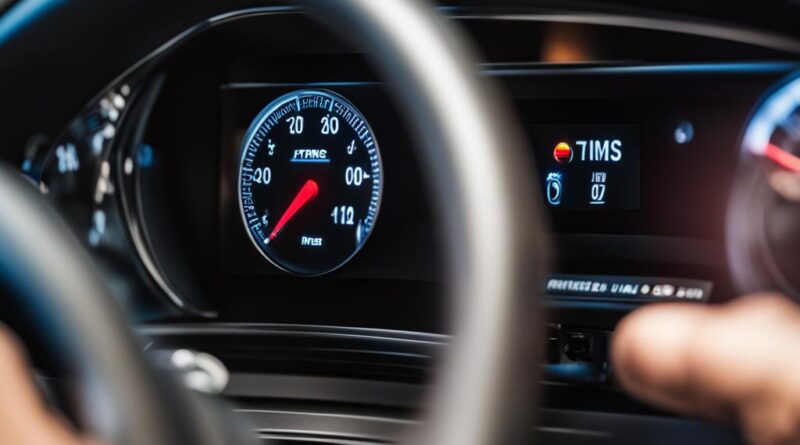Reset Tire Pressure Light on Honda CR-V Easily
When the “Low Tire Pressure” warning light illuminates on your Honda CR-V, it’s important to know how to reset it. This common issue for Honda owners can be easily resolved by following a few simple steps. By properly resetting the TPMS (Tire Pressure Monitoring System) light, you can ensure the accuracy of your tire pressure readings and maintain optimal performance and safety.
Key Takeaways:
- Resetting the tire pressure light on your Honda CR-V is a straightforward process.
- Properly resetting the TPMS light ensures accurate tire pressure readings.
- Maintaining optimal tire pressure promotes vehicle performance and safety.
- Ignoring the tire pressure warning light can lead to decreased fuel efficiency and tire wear.
- Consult your owner’s manual or the official Honda website for specific instructions.
+
How to Reset the TPMS Light on New Honda Vehicles
Newer Honda CR-V models with a touchscreen display or steering wheel buttons have different methods for resetting the TPMS light. For models with a touchscreen display, you can access the TPMS Calibration settings through the vehicle settings menu. On models without a touchscreen display, you can use the steering wheel buttons to navigate to the TPMS Calibration option.
“Properly resetting the TPMS light is crucial to maintaining accurate tire pressure readings.”
To reset the TPMS light on your Honda CR-V, follow these steps:
For Models with Touchscreen Display:
- Start the vehicle and ensure the parking brake is engaged.
- Tap the “Settings” icon on the touchscreen display.
- Navigate to the “Vehicle Settings” menu.
- Scroll down and select “TPMS Calibration.”
- Follow the on-screen prompts to reset the TPMS light.
For Models without Touchscreen Display:
- Start the vehicle and ensure the parking brake is engaged.
- Locate the buttons on the steering wheel for menu navigation.
- Use the buttons to scroll through the menu options.
- Select the “TPMS Calibration” option.
- Follow the on-screen prompts to reset the TPMS light.
If you need more detailed instructions specific to your Honda CR-V model, refer to your owner’s manual or visit the official Honda website for a comprehensive guide.
Resetting the TPMS light is an essential maintenance task that ensures accurate tire pressure readings and promotes optimal performance and safety on the road. Stay proactive with your Honda CR-V’s tire pressure monitoring system by resetting the TPMS light as needed.
How to Reset the TPMS Light on Older Honda Vehicles
If you have an older Honda CR-V model, the process of resetting the TPMS light may vary slightly. Models with steering wheel buttons can access the TPMS Calibration settings through the customization menu. For models without a touchscreen display, you can navigate to the TPMS Calibration option using the steering wheel buttons. Some older models may also have a dedicated TPMS button located near the steering wheel. It’s important to consult your owner’s manual for the specific instructions related to your vehicle.
Troubleshooting Tips for TPMS Light Issues
If the TPMS warning light continues to flash or remains on after following the reset procedure, it may indicate an underlying issue with the system. This can sometimes occur if a tire or wheel was replaced incorrectly, leading to an inaccurate TPMS reading.
To resolve this issue, it is strongly recommended to visit a certified Honda service center for professional diagnosis and repair. Certified technicians have the knowledge, expertise, and necessary equipment to accurately diagnose and resolve TPMS problems.
Attempting to fix the issue yourself without proper knowledge and equipment can potentially lead to further complications or incorrect troubleshooting. It’s best to rely on professional assistance to ensure the TPMS system is functioning correctly and providing accurate tire pressure readings.
By seeking professional help, you can have peace of mind knowing that the issue will be properly addressed, and any potential risks or safety hazards associated with inaccurate TPMS readings will be minimized.
Troubleshooting Tips:
- Visit a certified Honda service center for professional diagnosis and repair.
- Avoid attempting DIY fixes without proper knowledge and equipment.
- Rely on certified technicians to accurately diagnose and resolve TPMS issues.
Remember, your safety on the road is paramount, and correctly functioning TPMS is crucial for maintaining optimal tire pressure and performance.

| Issue | Possible Cause | Solution |
|---|---|---|
| TPMS light remains on | Incorrectly replaced tire or wheel | Visit a certified Honda service center for professional diagnosis and repair |
| TPMS light continues to flash | Underlying TPMS system malfunction | Seek professional assistance at a certified Honda service center |
Importance of Proper Tire Pressure and TPMS
Proper tire pressure is essential for maintaining optimal performance and safety of your Honda CR-V. Inadequately inflated tires can lead to various issues, including decreased fuel efficiency, premature tire wear, and even potential accidents on the road. That’s where the Tire Pressure Monitoring System (TPMS) becomes crucial. It serves as a helpful tool to monitor and alert drivers of any abnormalities in tire pressure.
Ignoring the tire pressure warning light can have severe consequences. It’s important to take prompt action whenever the TPMS light illuminates on your Honda CR-V’s dashboard. Regularly checking your tire pressure and resetting the TPMS as needed ensures that your vehicle remains safe and efficient.
By maintaining the proper tire pressure recommended by the manufacturer, you can experience improved handling and stability while driving. This contributes to a smoother and more comfortable ride, reducing the risk of accidents caused by tire-related issues.
Enhanced Fuel Efficiency
Keeping your tires properly inflated can significantly improve fuel efficiency, saving you money at the pump. Underinflated tires increase rolling resistance, causing your vehicle’s engine to work harder and consume more fuel. By regularly monitoring and maintaining the correct tire pressure, you can maximize fuel economy and reduce your carbon footprint.
Extended Tire Lifespan
Inadequate tire pressure can lead to uneven tread wear, shortening the lifespan of your tires. Over time, this can result in costly tire replacement. By resetting the TPMS regularly and ensuring proper tire pressure, you can extend the life of your tires, saving you money in the long run.
Improved Safety
Proper tire pressure is crucial for maintaining optimal traction and grip on the road. Underinflated tires can compromise your vehicle’s handling and braking capabilities, especially in hazardous road conditions. By resetting the TPMS and keeping your tire pressure within the recommended range, you enhance your safety and that of your passengers.
| Benefits of Proper Tire Pressure and TPMS | |
|---|---|
| Enhanced Fuel Efficiency | Extended Tire Lifespan |
|
|
| Improved Safety | |
|
Conclusion
Resetting the tire pressure light on your Honda CR-V is a simple and important task that ensures the safety and efficiency of your vehicle. By following the specific instructions provided in your owner’s manual or consulting the official Honda website, you can easily reset the TPMS light and avoid potential issues.
Regularly checking your tire pressure is crucial, especially after inflation, rotation, or replacement. By maintaining the proper tire pressure and resetting the TPMS as needed, you can prevent decreased fuel efficiency, tire wear, and accidents. Don’t ignore the tire pressure warning light – take the necessary steps to keep your Honda CR-V in optimal condition.
Remember, a well-maintained tire pressure monitoring system contributes to a smooth and safe driving experience. Prioritize the regular check-up of your tire pressure and promptly reset the TPMS light whenever necessary. By doing so, you can have peace of mind knowing that your Honda CR-V is performing at its best while ensuring your safety on the road.
FAQ
How do I reset the tire pressure light on my Honda CR-V?
To reset the tire pressure light on your Honda CR-V, follow the specific instructions provided in your owner’s manual or consult the official Honda website for detailed step-by-step guidance.
How do I reset the TPMS light on newer Honda vehicles?
If you have a newer Honda CR-V model with a touchscreen display, access the TPMS Calibration settings through the vehicle settings menu. For models without a touchscreen display, use the steering wheel buttons to navigate to the TPMS Calibration option.
How do I reset the TPMS light on older Honda vehicles?
If you have an older Honda CR-V model with steering wheel buttons, access the TPMS Calibration settings through the customization menu. For models without a touchscreen display, navigate to the TPMS Calibration option using the steering wheel buttons.
What should I do if the TPMS warning light continues to flash or remains on after resetting?
If the TPMS warning light continues to flash or remains on after following the reset procedure, there may be an issue with the system. Visit a certified Honda service center for professional diagnosis and repair.
Why is it important to maintain proper tire pressure and reset the TPMS?
Maintaining proper tire pressure is crucial for optimal vehicle performance and safety. Underinflated tires can lead to decreased fuel efficiency, tire wear, and accidents. The TPMS serves as a valuable tool to monitor and alert drivers of any tire pressure abnormalities.




